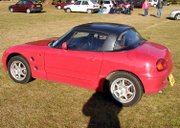| |
Keicars
Car Show
Keicars
 Daihatsu Copen
Daihatsu Copen
 Daihatsu Cuore
Daihatsu Cuore
 Suzuki Cappuccino
Suzuki Cappuccino
 Subaru R1
Subaru R1
Keicar (K-car), also called keijidōsha (in
Japanese: 軽自動車 light motor vehicle), is a
Japanese category
of small
automobiles, including passenger cars as well as vans and pick-up trucks for
commercial use. They are mainly designed for sale in Japan, because there are
some tax and insurance relaxations and an exemption from the usual requirement
of certification that one has adequate parking space at his or her home or has contract for a parking spot.
These relatively relaxed standards came from the post-World War II days when
most Japanese were too poor to buy a fullsized car, yet had more than enough
money to buy a motorcycle. To promote the growth of car industry as well as to
offer an alternative delivery method to small business and shop owners, Keicar
standards were created. In Japan, the cars feature yellow licence plates,
earning them the name "yellow-plate cars" in English-speaking circles (black
numbers on yellow background for private use and yellow numbers on black
background for commercial use). The keicar field is very competitive, so that
manufacturers are in a constant race to provide better performance, utility, and
fun within the keicar regulations, driving the pace of technological innovation,
which then spreads to the rest of their automobile line. As a result, keicars
are available with turbocharged engines, automatic transmissions, continuously
variable transmissions, front wheel drive, rear wheel drive,
four wheel drive,
hybrid drivetrains, air conditioning systems as well as navigation systems.
History and regulations
- July 8, 1949: first
regulations
- length: up to 2.8
m
- width: up to 1 m
- height: up to 2 m
-
engine displacement: up to 150 cc (4-stroke), up to 100 cc; (2-stroke)
- July 26, 1950: major
changes
- length: up to 3 m
- width: up to 1.3 m
- displacement: up to 300 cc; (4-stroke), up to 200 cc; (2-stroke)
- August 16, 1951:
minor changes
- displacement up to 360 cc; (4-stroke), up to 240 cc; (2 stroke)
- April 4, 1955: minor
changes
- no further differentiation between 2-stroke and 4-stroke: all up to
360 cc
- January 1, 1976:
major changes
- length: up to 3.2 m
- width: up to 1.4 m
- displacement: up to 550 cc
- January 1, 1984:
medium changes
- length: up to 3.4 m
- displacement: up to 660 cc
- October 1, 1998:
today's regulations
- length: 3.4 m or less
- width: 1.48 m or less
- height: 2 m or less
- displacement: up to 660 cc
Manufacturers of keicars
Daihatsu
Honda
Toyo Kogyo/Mazda
Mitsubishi Motors Corporation
Nissan
Smart (the only non-Japanese company)
Fuji Heavy Industries/Subaru
Suzuki
Famous example cars
For details see the category for keicars.
Autozam AZ-1 (turbocharged sports car with gullwing doors)
Daihatsu Copen (a convertible with a turbocharged engine, now sold in
Europe)
Daihatsu Mira, also known as Cuore (sold with some minor changes in Europe)
Honda Beat (a convertible with a mid-mounted engine and rear wheel drive)
Mazda Carol (The Carol's engine was the only four-cylinder in the 360 cc
class)
Subaru R1
Suzuki Cappuccino (also a convertible, was also sold in UK)
Suzuki Twin (a hybrid vehicle)
Suzuki Wagon R (sold with larger engines in Europe, also sold as the Opel
Agila)
See also
External links
Home | Up | List of cars | Vehicle size class | Microcars | Hatchback | Sedan | Station wagon | Sportive cars | Cabriolet | Convertible | Four-wheel drive | Minivan | Brass Era car | Personal luxury car | Recreational vehicle | Vintage car | Full-size vehicles | Keicars | Hybrid vehicles | Luxury vehicles | Mid-size car | Pickup trucks | Prestige vehicles | Production Electric vehicles | 2 plus 2 | Air car | Compact SUV | Concept cars | Cyclecar | Leisure activity vehicle | Limousine | Personal luxury car | Pony car | Professional car | Safety car | Show car | Sport compact | Voiturette | Green vehicles | Off-road vehicles | Steam automobiles
Car Show, made by MultiMedia | Free content and software
This guide is licensed under the GNU
Free Documentation License. It uses material from the Wikipedia.
|
|







